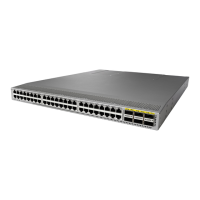Send comments to nexus3k-docfeedback@cisco.com
-SM-95
Cisco Nexus 3000 Series NX-OS System Management Command Reference
OL-29557-04
Chapter System Management Commands
ip name-server
ip name-server
To configure a name server, use the ip name-server command. To disable this feature, use the no form
of the command.
ip name-server ip-address [use-vrf name]
no ip name-server ip-address [use-vrf name]
Syntax Description
Command Default None
Command Modes Global configuration mode
VRF context configuration mode
Command History
Usage Guidelines Use the ip name-server command to configure the name server for the device. Use the vrf context
command to enter the VRF context mode to configure the domain names for a particular VRF.
Examples This example shows how to configure the IP name server for the default VRF:
switch# configure terminal
switch(config)# vrf context management
switch(config-vrf)# exit
switch(config)# ip domain-name Mysite.com use-vrf management
switch(config)# ip name-server 192.0.2.1
switch(config)#
This example shows how to configure the IP name server for the management VRF:
switch# configure terminal
switch(config)# vrf context management
switch(config-vrf)# ip name-server 192.0.2.1
switch(config-vrf)#
This example shows how to configure the IP name server for the default VRF to use the management
VRF as a backup if the IP name server cannot be reached through the default VRF:
switch# configure terminal
switch(config)# vrf context management
switch(config-vrf)# exit
ip-address IP address for the name server.
use-vrf name (Optional) Specifies the virtual routing and forwarding (VRF) to use to reach
the name-server. The name can be any case-sensitive, alphanumeric string up
to 32 characters.
Release Modification
5.0(3)U1(1) This command was introduced.

